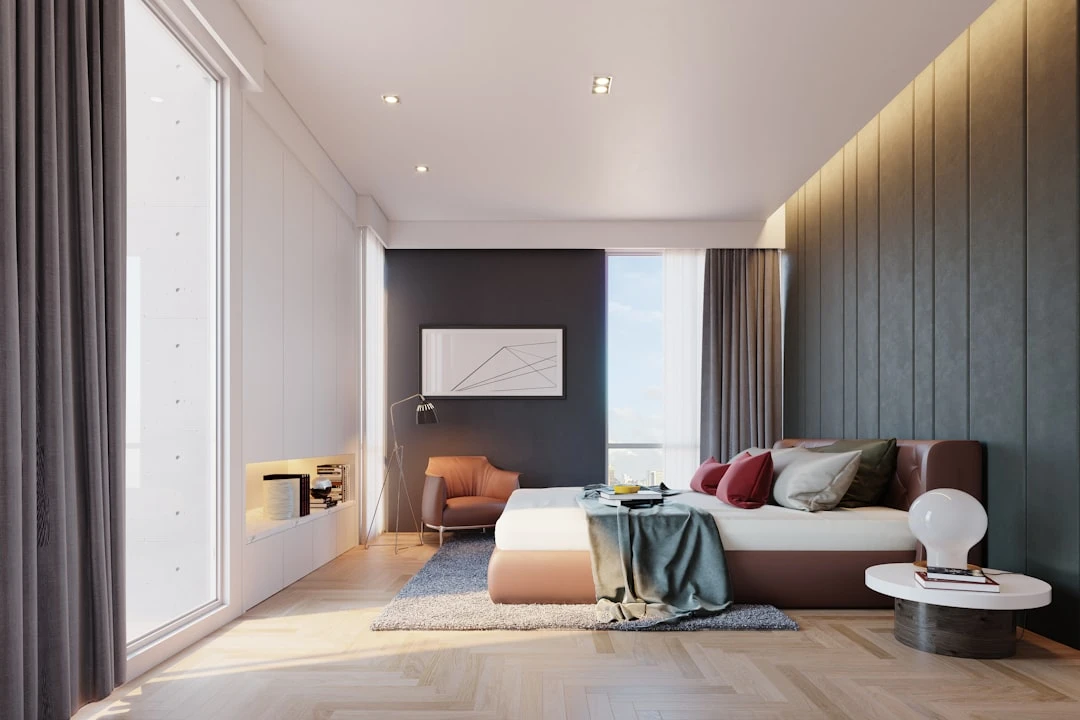Bedroom Interior Design for Better Sleep

Have you noticed that despite sleeping for 8 hours, you still wake up exhausted? When it comes to sleep quality, the interior design of your bedroom can play an unexpectedly significant role. The right color scheme, lighting, and furniture arrangement directly affect your sleep rhythm and quality.
Lighting – the foundation of sleep quality
Light significantly affects our circadian rhythm and melatonin production. During evening hours, your bedroom should be dominated by warm, yellowish light, which stimulates the production of sleep hormones. At the same time, you should avoid screens emitting blue light at least 2-3 hours before bedtime, as these inhibit melatonin production and make it harder to fall asleep.
Installing dimmable lights allows you to gradually reduce light intensity in the evening, helping your body prepare for sleep. During the day, it is important to get enough daylight – at least 30 minutes – which helps regulate your natural sleep-wake cycle. During winter, when daylight is scarce, using daylight lamps can help reduce the time it takes to fall asleep.
A color palette that promotes sleep
Choosing the color scheme for your bedroom is not merely an aesthetic question, but directly affects our mood and ability to fall asleep. The best color choices for a bedroom are soft, natural tones like light blue, blue-green, and beige, which create a calming atmosphere. These cool tones help lower body temperature, which in turn promotes falling asleep.
You should avoid bright and stimulating colors such as bright red, yellow, and orange, which create restlessness and can make it harder to fall asleep. The color palette should be balanced and harmonious, leaving the room as a completely calming rest zone.
Furniture arrangement in the service of sleep
The furniture arrangement in your bedroom not only affects the room's functionality, but also our subconscious sense of security and energy flow. Ideally, the bed should be positioned so that when sleeping, you can see someone entering, but are not directly opposite the door. This creates a subconscious sense of security, which helps you relax more deeply.
A mirror should not be placed where the bed is visible from it, as this can create psychological restlessness. As Bonami recommendations show, good energy flow in the bedroom is important – so you should leave enough free space around the bed and avoid excessive furniture.
A minimalist approach to bedroom furnishing helps reduce visual noise and creates peace of mind, which is a prerequisite for quality sleep. A room that is too densely packed can create subconscious anxiety and a feeling of claustrophobia.
Materials and textures in a sleep-friendly bedroom
The choice of materials in the bedroom affects both aesthetic appearance and air quality. Natural textiles such as cotton, linen, and bamboo are ideal for bedding, as they allow air to circulate freely and regulate moisture. Non-allergenic materials, especially those certified with OEKO-TEX® STANDARD 100, significantly reduce the possibility of allergic reactions, which can worsen sleep quality.
When choosing furniture, you should prefer natural materials such as wood and cork, which balance room humidity levels and create a harmonious whole. Changing bedding at least twice a week is one of the easiest ways to reduce the amount of dust mites and other allergens, which often cause sleep problems.
Air quality and temperature
Air quality is often overlooked, but an extremely important aspect of improving sleep quality. Regular ventilation of the bedroom – at least 15 minutes a day – helps remove carbon dioxide and other pollutants that can cause headaches and fatigue.
The optimal bedroom temperature is 16-18°C in winter and 18-20°C in summer. A bedroom that is too warm causes restless sleep and frequent awakenings, while a cooler environment promotes deeper sleep. In addition to regulating light, darkening curtains also help maintain a more stable temperature in the room.
Plants such as snake plant not only purify the air, but also create a nature-like and calming atmosphere. At the same time, you should avoid spiky plants, which according to feng shui principles can create sharp energy flows and restless sleep.
Small budget changes to improve sleep
Ensuring quality sleep does not necessarily require major investments. Replacing a light bulb with a warmer light-emitting variant is a simple and affordable way to change the evening atmosphere. Using darkening curtains or a sleep mask helps block out distracting light, especially in urban areas.
Natural scents such as lavender have a relaxing effect and can improve sleep quality. A bedroom free of electronic devices significantly reduces distracting factors – if removing devices is not possible, you should at least cover them at night to avoid the disturbing effect of small lights and screens.
Even such a simple action as closing cabinet doors and drawers before bedtime helps create an organized environment that promotes peace of mind and unobstructed energy flow in the room.
Conclusion
The impact of bedroom interior design on sleep is significant, and fortunately, many solutions are easily implemented. Proper lighting, calm colors, thoughtful arrangement, and quality materials create the foundation for good sleep, which in turn affects health, well-being, and overall quality of life.
Are you looking for a new home where you could create an ideal bedroom to improve your sleep? On the Kinnisvara24 portal you can find a wide selection of apartments and houses that suit your needs. Or perhaps you would like to consult with an experienced real estate agent who can recommend homes where the bedroom has the best conditions for quality sleep? Learn more about Kinnisvara24 offerings – good sleep is just one decision away!




